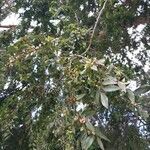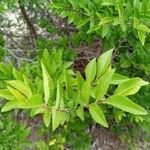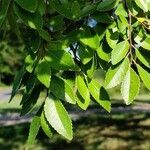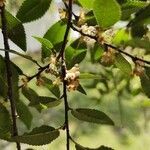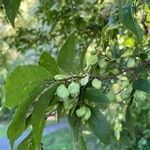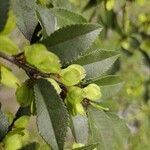Trees , 25 m; crowns rounded, open. Bark olive green to gray, shedding in irregular, tan to orange plates. Branches long-pendulous, not winged; twigs tan to dark brown, glabrous to pubescent. Buds acute to obtuse; scales brown, pubescent. Leaves: petiole 2-6(-8) mm, glabrous or sparsely pubescent with short hairs. Leaf blade elliptic to ovate-obovate, (3.5-)4-5(-6) × 1.5-2.5 cm, base oblique, margins mostly singly serrate (some doubly serrate), apex acute; surfaces abaxially pale, glabrate, adaxially dark green, lustrous, glabrous; lateral veins forking 5 or more times per side. Inflorescences fascicles, (2-)3-4(-8)-flowered; pedicel 8-10 mm. Flowers: calyx reddish brown, deeply lobed, lobes (3-)4-5, glabrous; stamens 3-4; anthers reddish; stigma lobes white-pubescent, exserted, recurved and spreading with maturity. Samaras green to light brown, elliptic to ovate, ca. 1 cm, not winged, seeds nearly filling samara, notched at apex, glabrous. Seeds thickened, not inflated. 2 n = 28.
An elm tree. It grows 15 m tall. It is spreading and loses many of its leaves during the year. The branches tend to hang down. The trunk has smooth bark which flakes off showing orange brown patches. It has small leaves. The leaves are narrowly oval and 6 cm long by 4 cm wide. They are unequal at the base. The leaves are pointed and have sharp teeth. They are glossy dark green above with hairs underneath. They turn yellow, red, or purple in autumn. The flowers are very small and red. They are in clusters in the axils of leaves. The fruit is a small seed with wings. It is 8 mm long.
Medium-sized tree, up to 6 m high. Stems with branchlets thinly pubescent, branches without spines. Leaves petiolate; blade elliptic to ovate, small, 25-45 x 10-20 mm long, base asymmetric, apex acute, margins serrate, leathery, glossy green on upper surface, prominently veined on lower surface, glabrous; stipules present, falling early. Flowers: inconspicuous; Mar. Fruit a flattened samara with membranous wings.
Perennial tree, 2-25 m high, bark grey, smooth. Leaves pinnately veined, ovate to elliptic, surface glossy, apex acute, up to 40 x 20 mm; petioles up to 6 mm long, glabrous. Inflorescences pendent fascicles, axillary. Perianth deeply lobed. Stamens 3-5, usually exserted; anthers reniform. Fruit a glabrous samara with 2 wings, brown, up to 8 mm long. Seeds compressed, ovate.
Medium-sized tree. Branchlets thinly pubescent. Leaves small, 25-80 mm long, elliptic to ovate, leathery and glossy green.
Pending. See Bibliography.
